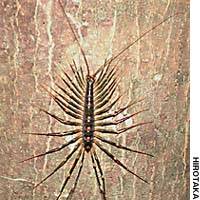* Japanese name: Oogeji
* Scientific name: Thereuopoda clunifera
* Description: Someone went a bit leg-crazy when naming these animals. Although they are called centipedes (the name means "100 legs"), oogeji have only 15 pairs of legs. They are not insects (all of which have just three pairs of legs) -- they are myriapods ("many legs"). Insects and centipedes, by the way, all belong to the phylum Arthropoda ("jointed leg"). Giant centipedes have a long, flattened, segmented body and can grow to more than 20 cm long. The head segment is domed, with appendages modified to form sharp fangs. The scientific name, thereuopoda, means "hunting legs."
* Where to find them: From Honshu to Kyushu, under stones, the bark of trees or fallen leaves, and in caves.
* Food: Insects, snails, earthworms. Giant centipedes can move fast and, unusually, they hunt during the day. When they bite, venom glands inject poison into the prey. They may also bite humans, and though the bite can be painful, it is not dangerous.
* Special features: When they hatch, giant centipedes have only seven pairs of legs. What's unusual is that after each molt, a new segment -- and a new pair of legs -- is added. They have the useful and surprising ability to shed their legs if caught by a predator.
1 mins ago


















With your current subscription plan you can comment on stories. However, before writing your first comment, please create a display name in the Profile section of your subscriber account page.